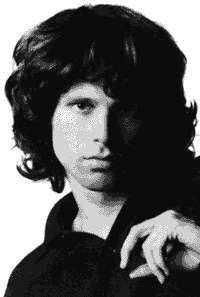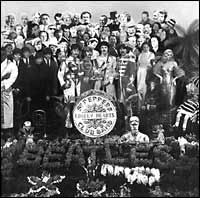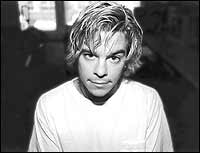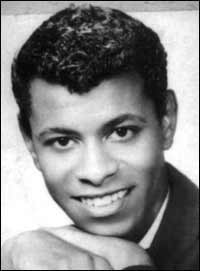b y G e n e S c u l a t t i
Who's the perp? Somebody must've done this.
The victim's been lying there on life-support for years. Once a big, strapping music, light on its feet, unstoppable in its ability to move and shake all kinds of listeners, it fades in and out of consciousness, listless and unfocused.
Even without invoking the golden days of two and three decades ago, popular music today - an enervating mix of a-melodic R&B, lachrymose little-girl songwriter shlock and brutish fratboy b.s. - and posing, ever more posing - pales against any measurement standard.
As the wise solon Andy Kim once inquired, "Baby, how'd we ever get this way?"
Well, some folks suspect corporate-driven record companies, others point to research-run radio. Those two've done their damage, sure, but I think the real culprit are myths. For almost 30 years, rock music's been a prisoner of some powerful, essentially bogus "natural laws" that have shaped artists' and audiences' perceptions and behavior. Unchecked and unchallenged, these myths have resulted in an ever-narrowing definition of what R&R is and how it works; they've gutted its vocabulary, limited its expressiveness and left us with the soul-numbing jive that now surrounds us.
Now, ladies and gentlemen, let's meet our myths...
Myth #1: Rock Is Art
This nifty bondage outfit dates back to 1967. That's when the mainstream media declared legit the music it had dissed for more than a
 |
 |
 |
|
THE USUAL SUSPECTS From Top: The Lizard King, Sgt. Pepper's & James of PopSmear magazine |
OK, rock did do some real growing up in the 60s: "Like A Rolling Stone" - one of the 20th Century's true cosmos-rattling works - was surely no "Teen Angel." But then "White Room" and "Marrakesh Express" were no "Like A Rolling Stone."
The Rock Is Art myth was largely institutionalized by the late '60s/early '70s advent of rock journalism: If rock was legit enough to be written about, it must be Saying Something. And unless it was Saying Something, it wasn't rock. Since the principal means of saying anything is words, the gradual ascent of lyrics over sound was assured (Rolling Stone found little to evaluate in the output of such lyrically irrelevant acts as Slade, T. Rex, the Dolls or Ramones - just as it would've been speechless on Big Joe Turner or the Trashmen or, for that matter, the Marcels). In time, audience and artists alike came to assume that pop music was supposed to carry content.
Which meant that, before long, you had only to present yourself as a poet - the jasmine-sniffing psychedelic clods, the prog-rockers, smug-ass solo Lennon or the gifted seer Jimbo M - to be taken as one. The Lizard King, in fact, created the Tortured Artist template for all who've followed. See his intense gaze and self-absorption, his irrefutable claim to be dropping science big-time, in Stipe and Sting, in Amos, Bono, Badu, and Vedder, and Ndegeocello and hundreds of others.
The irony is that now, after 30 years of Myth No. 1's dominance, the thousands of kids who yearly make pop music a career choice (you could've gotten committed for this in pre-Beatles days) probably think their songs (or "works") are going to change the world.
Either that or they're paying obeisance to ...
Myth #2: Rock Is Rebel Music
"Everything is so tame and so driven by corporations. But it hasn't been possible for them to take over and use the images of serial killers. It's the only thing that's still truly underground and alternative." - James, publisher of PopSmear magazine, quoted in the L.A. Times, 8/4/99
But of course. The fallout from Myth No. 2 is everywhere; you can't walk anywhere without stepping in it. Its origins, too, lie deep in the mainstream's earliest attempts to understand the music - i.e., Catholic and fundamentalist-clergy denunciations of r&r as a soundtrack for juvenile delinquency, Sinatra's pronouncements against Presley, racist tirades about the rise of "jungle music." And, as with the music's '60s adolescence, there's truth here: to old-line publishers, promoters and broadcasters, this new thing really was wild and threatening.
It wasn't until the '60s and '70s that the rock=rebellion myth was institutionalized and, it often seems, stamped into the genetic code of almost everyone who would ever listen to the music. Key players include Stones manager Andrew Oldham, who shrewdly marketed his act as the anti-Beatles, and, later, the rock-crit establishment. Pop-music histories of the '70s, '80s and '90s tell and re-tell the tale of rock's rebel routes - for example, reserving major props for Gene Vincent (pain-addled, pill-addicted, died poor) while skimming over Fats Domino (mild-mannered family man, made some of the most joyous r&r the world's ever heard). (In the liner notes to a recent Faces reissue, Dave Marsh feverishly recalls the band's concerts: "They took the stage the way a teenage gang takes over a corner." Careful with that truncheon, Roddy.)
By now, rock's parade of self-proclaimed rebels resembles a clogged freeway. Stuck in traffic: Jefferson Airplane and the MC5 (raised-fist leftist rants signifying nothing), the Metal nation (30 years of taking Halloween seriously), country-rock's "outlaw movement" (millionaire songwriters revolt against bridges and choruses), and first-gen punks (did anyone really expect Western society to slip into anarchy?). In the driver's seat today: gangsta rap (endless tales of unsavory behavior, inspired by fascinating "real life" experiences) and the "hard music" wing of Alternative Nation (white guys' tales of unsavory behavior, often inspired by an endless fascination with Chuck Manson). Memo to James of PopSmear: Don't flatter yourself: Ford and GMC will one day use images of Gacy and Dahmer to move tough trucks.)
The net effect of these two myths has been a gradual strangulation of rock 'n' roll, ever tightening the popular definition of the music. An aesthetic freeze-out now rules: If the music you're making isn't Serious (self-fixated, "poetic" proclamations: Morissette is Jewel is Rollins) or Dangerous (NIN, Marilyn Manson, Korn, Rage), you're engaged in frivolous activity - in a word, "pop." (Fear of the p-word is epidemic: Dig the way so many alt-rock bands craft catchy-as-hell melodies, then sing them with deliberately "off" vocals - to make sure you know they're not trying to be Anka or Astley.)
 |
|
MYTH-SMASHER Gino Washington |
So, with the patient hanging on by a thread, is there a chance of recovery? Maybe. If artists can break the myth-mold and restore the musical vocabulary, they might find the inspiration to revive the old dame.
As a listener, I know that my favorite rock 'n' roll CDs lately are albums that were either produced before the rule of Myths 1 and 2, or, because of cultural lag-time, transcend them altogether. Norton's reissue of Detroit soulster Gino Washington's lost catalog is a pre-myth monster: melodic, celebratory, so raggedly noisy it's almost out of control. Bossa Cubana, by Cuba's '50s/early '60s vocal group Los Zafiros, is sublimely beautiful (if Happy Days stereotyping has stood in the way of your appreciating the soul and sonic sculpture of doowop, try this). Gear Blues, by Japan's contemporary four-piece Thee Michelle Gun Elephant (one theory suggests the name's a misreading of "Machine Gun Etiquette"), relentlessly rocks out with Dictators/MC5 fury - and you needn't understand a syllable to catch the fire.
Are any of these records Saying Something about life today or man's fate? Probably not. Are they dangerous acts of rebellion? In a world so suspicious of spontaneity, unfaked emotion and fun, you bet they are.
° ° °
Gene Sculatti is the editor of the booksThe Catalog Of Cool andToo Cool. He's readying a third Cool compendium for 2001.